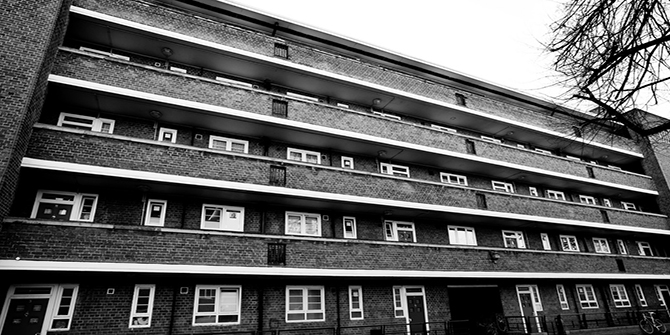Housing has become seriously unaffordable, the problem is likely to get worse, and the young are hit the hardest. Christian Hilber argues that we face a conundrum: Reforms that would be effective are considered politically infeasible, and policies that are popular are ineffective or, worse: counterproductive. Solving the conundrum requires persuasion and a special kind of coalition.
The most common measure of housing affordability is the house price-to-income multiple. Houses are considered affordable if median prices are no more than three times median salaries. In England and Wales in 2022, the median annual earnings for someone on a full-time salary was £33,400. This would mean an affordable home would be around £100,000. Instead, the median price of a housing unit was £270,000. The situation is considerably worse in London and the South East of the country.
The housing affordability crisis is particularly severe in parts of England. But it is a global phenomenon. Housing affordability has deteriorated for decades, especially in major cities and tourist locations. In 2021, based on a sample of over 400 metro areas in nine countries, including the UK, there were five times as many metro areas with multiples above 10, compared to just a decade ago.
Falling interest rates partly explain this trend. But affordability has seriously deteriorated even when taking interest rates into account: the ratio of first-time buyer mortgage loans as a percentage of take-home pay doubled in the UK between 1995 and 2022, increasing by 160 per cent in London. The problem is also not just confined to house prices and would-be-buyers, private rents are also seriously unaffordable relative to earnings.
The affordability crisis in the UK has hit the younger generation the hardest. For decades, the homeownership rate has been increasing steadily for over 65-year-olds. However, homeownership among the 25- to 34-year-olds peaked during the late 1970s. It fell by half from 1989 to 2016. The number of adults living with parents in England and Wales rose by 700,000 in a decade to 4.9 million. But the crisis does not only create generational inequality. High housing costs increasingly discourage workers from moving to the most productive cities, hampering economic growth.
So why has housing become so unaffordable in the UK?
The main explanatory factors arguably are a combination of severe supply constraints in desirable cities such as London, Oxford, or Cambridge in conjunction with growing demand for housing in these locations.
The rising demand for housing is mainly the result of rising real incomes and, to a lesser extent, population growth. Rising demand does not necessarily decrease housing affordability. In fact, to the extent supply is responsive, increasing real incomes should make housing more affordable. Similarly, the ongoing fall in real house prices does not necessarily make housing more affordable. The price decline may be primarily driven by falling real incomes and a poor economic outlook.
The main issue is unresponsive supply. We have not built nearly enough houses in this country to keep housing affordable. Between 1970 and 2022, house prices in the UK increased in real terms by 441 per cent, yet construction fell by 46 per cent, from 378,320 to 205,340 units.
We have not built nearly enough houses in this country to keep housing affordable.
But why is supply so unresponsive to rising prices? The main culprit is regulatory supply constraints. The British “development control” planning system is highly inflexible. Moreover, its decision-making is unpredictable, adding risk to the development process. Its primary effect is to constrain development.
On top of a highly restrictive approval process that caters to NIMBY residents, development is constrained in all directions. Large English cities cannot grow horizontally because they are surrounded by massive green belts. Residential land use is off-limits in these areas, even close to existing transport nodes. But green belts do not limit polluting intensive agriculture. Height restrictions and view corridors are the main constraints preventing vertical expansion.
The protected view corridor from King Henry XIII Mound in Richmond Park onto St. Paul’s Cathedral, for example, benefits only a few. The opportunity costs in the form of foregone construction, higher property prices, and rents across the capital are huge. But (almost) nobody knows! Lastly, many inner cities are, to a good extent, “preserved” by Conservation Areas and Listed Buildings. These prevent redevelopment at higher density and higher energy efficiency.
Conservative estimates suggest that if the South East of England (the most restrictive English region) had the restrictiveness of the North East (the least restrictive region, but still highly restrictive by international standards), house prices in 2008 would have been 25 per cent lower.
To make matters worse, the benefits associated with permitting residential development and the costs are not geographically aligned. Planning decisions in England are made by Local Authorities (LAs). They face the brunt of the cost of providing additional infrastructure and services. Moreover, local officials are elected by NIMBY residents who fear that residential developments shrink local school catchment areas, make local roads more congested, or obstruct views. Despite facing most of the cost, LAs (and existing residents) reap few of the benefits in the form of additional local revenue (through the Council Tax). Moreover, this extra revenue is redistributed away again through the central government grants system.
New residential construction does generate wider benefits in the form of lower housing costs and, thus, more housing consumption per capita. But these benefits typically do not accrue locally (and if they do, existing homeowners don’t like them because it also means their assets have become less valuable). Instead, they accrue at a much broader geographical scale. Each additional development only marginally reduces market-wide housing costs. The cost adjustment becomes large only in the aggregate.
All of this suggests that local officials have virtually no positive fiscal or other incentives to permit residential development.
The housing affordability conundrum
Resolving the crisis would require some radical reforms. Reform the planning system away from the extraordinarily restrictive and idiosyncratic development control system towards a rule-based zoning system. Redesign the system to cater less to NIMBY pressures and focus more on its core purpose: correcting “market failures”. Require horizontal and vertical planning constraints to undergo social cost-social benefit considerations, and if the (opportunity) costs exceed the benefits, they should go. Replace Section 106 agreements with a Developer Levy. Phase out the highly inefficient Stamp Duty Land Tax and replace it – in a revenue-neutral way – with a much-reformed Council Tax. The latter should become a proper local annual tax on property values, and LAs should be allowed to keep the revenues.
The trouble with these proposed reforms is that they are unpopular amongst policymakers wanting to get re-elected. Such reforms are complex, have an implementation cost, and the benefits accrue only in the future. Moreover, the “median voter” in the UK is an existing homeowner who likely believes themselves to be a beneficiary of the status quo with rising house prices.
The trouble with these proposed reforms is that they are unpopular amongst policymakers wanting to get re-elected.
It is much easier for policymakers to enact new policies that stimulate housing demand. But these demand-side policies are, at best, ineffective or often counterproductive, especially in desirable and supply-constrained areas where housing is most desperately needed.
The government’s Help to Buy equity loan scheme is a perfect example. A recent evaluation reveals the policy not only failed to induce additional housing construction in the severely supply-constrained Greater London but also increased the price of new build houses by far more than the implicit government subsidy.
The policy did work “better” near the English/Welsh border where supply is less constrained. But housing is needed where affordability is worst and productive jobs are located, not in remote areas where housing is still reasonably affordable. If anything, Help to Buy “helped” increase commuting distances further, contributing to carbon and other emissions.
How to solve the conundrum?
At a superficial level, the answer is straightforward. Reform the planning and tax systems to increase housing supply. Only this does not happen.
One fundamental issue is that existing homeowners believe that they benefit from the status quo with ever-rising house prices. This view is flawed for at least three reasons. First, existing homeowners can only actually unlock their housing wealth if they sell and move to a much less desirable place or leave the country. Second, our well-being is driven by how much housing (of a certain quality) we consume and where we consume it, not by how much our house is worth. The sad truth is that many of us live in cramped and subpar housing too far from the workplace precisely because it is so limited in supply and, therefore, expensive. Third, many existing homeowners are older and have children who are themselves desperately looking for adequate housing. Parents may not realise that their opposition to reform indirectly hurts their offspring.
Solving the conundrum requires two things to happen. First, the conundrum is partly the result of poorly informed voters. It is crucial to persuade the “median voter” that they may not benefit from the status quo and convince benevolent policymakers that demand-side policies “hurt” rather than “help”. Second, the young and their YIMBY movement do not have a political majority. To succeed, they must persuade altruistic parents and grandparents that radical reforms are desperately needed. In other words, what is needed is a coalition across generations.
To explore this topic further, listen to Christian Hilber discuss How can we make housing more affordable? on the LSE iQ podcast.
All articles posted on this blog give the views of the author(s), and not the position of LSE British Politics and Policy, nor of the London School of Economics and Political Science.
Image credit: Photo by Gunner Ridderstrom via Unsplash.






